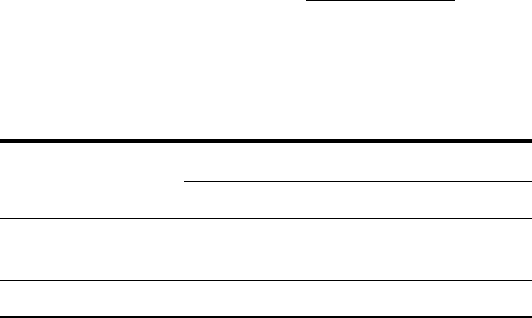Daniel W.W. Biostatistics: A Foundation for Analysis in the Health Sciences
Подождите немного. Документ загружается.


We may construct a confidence interval for RR
(12.7.2)
where is the two-sided z value corresponding to the chosen confidence coefficient and
is computed by Equation 12.4.1.
Interpretation of
RR
The value of RR may range anywhere between zero and
infinity. A value of 1 indicates that there is no association between the status of the risk
factor and the status of the dependent variable. In most cases the two possible states of the
dependent variable are disease present and disease absent. We interpret an RR of 1 to mean
that the risk of acquiring the disease is the same for those subjects with the risk factor and
those without the risk factor. A value of RR greater than 1 indicates that the risk of acquir-
ing the disease is greater among subjects with the risk factor than among subjects without
the risk factor. An RR value that is less than 1 indicates less risk of acquiring the disease
among subjects with the risk factor than among subjects without the risk factor. For exam-
ple, a risk factor of 2 is taken to mean that those subjects with the risk factor are twice as
likely to acquire the disease as compared to subjects without the risk factor.
We illustrate the calculation of relative risk by means of the following example.
EXAMPLE 12.7.1
In a prospective study of pregnant women, Magann et al. (A-16) collected extensive
information on exercise level of low-risk pregnant working women. A group of 217
women did no voluntary or mandatory exercise during the pregnancy, while a group of
238 women exercised extensively. One outcome variable of interest was experiencing
preterm labor. The results are summarized in Table 12.7.2.
We wish to estimate the relative risk of preterm labor when pregnant women exer-
cise extensively.
Solution: By Equation 12.7.1 we compute
RR =
22>238
18>217
=
.0924
.0829
= 1.1
X
2
z
a
10011 - a2%CI = RR
1;1z
a>
2X
2
2
12.7 RELATIVE RISK, ODDS RATIO, AND THE MANTEL–HAENSZEL STATISTIC
637
TABLE 12.7.2 Subjects with and without the Risk Factor Who Became Cases of
Preterm Labor
Risk Factor Cases of Preterm Labor Noncases of Preterm Labor Total
Extreme exercising 22 216 238
Not exercising 18 199 217
Total 40 415 455
Source: Everett F. Magann, Sharon F. Evans, Beth Weitz, and John Newnham, “Antepartum, Intrapartum,
and Neonatal Significance of Exercise on Healthy Low-Risk Pregnant Working Women,”
Obstetrics and
Gynecology, 99
(2002), 466–472.

These data indicate that the risk of experiencing preterm labor when a
woman exercises heavily is 1.1 times as great as it is among women who do
not exercise at all.
We compute the 95 percent confidence interval for RR as follows. By
Equation 12.4.1, we compute from the data in Table 12.7.2:
By Equation 12.7.2, the lower and upper confidence limits are, respec-
tively, and Since the interval
includes 1, we conclude, at the .05 level of significance, that the population
risk may be 1. In other words, we conclude that, in the population, there may
not be an increased risk of experiencing preterm labor when a pregnant
woman exercises extensively.
The data were processed by NCSS. The results are shown in Figure
12.7.1. The relative risk calculation is shown in the column at the far right
of the output, along with the 95% confidence limits. Because of rounding
errors, these values differ slightly from those given in the example. ■
Odds Ratio When the data to be analyzed come from a retrospective study, relative
risk is not a meaningful measure for comparing two groups. As we have seen, a retro-
spective study is based on a sample of subjects with the disease (cases) and a separate
sample of subjects without the disease (controls or noncases). We then retrospectively
determine the distribution of the risk factor among the cases and controls. Given the results
of a retrospective study involving two samples of subjects, cases, and controls, we may
display the data in a table such as Table 12.7.3, in which subjects are dichotomized
with respect to the presence and absence of the risk factor. Note that the column head-
ings in Table 12.7.3 differ from those in Table 12.7.1 to emphasize the fact that the data
are from a retrospective study and that the subjects were selected because they were either
cases or controls. When the data from a retrospective study are displayed as in Table
12.7.3, the ratio , for example, is not an estimate of the risk of disease for sub-
jects with the risk factor. The appropriate measure for comparing cases and controls in a
retrospective study is the odds ratio. As noted in Chapter 11, in order to understand the
a>1a + b2
2 * 2
1.1
1+1.96>1.1274
= 1.86.1.1
1-1.96>1.1274
= .65
X
2
=
4553122211992- 1216211824
2
1402141521238212172
= .1274
638 CHAPTER 12 THE CHI-SQUARE DISTRIBUTION AND THE ANALYSIS OF FREQUENCIES
Odds Ratio and Relative Risk Section
Common Original Iterated Log Odds Relative
Parameter Odds Ratio Odds Ratio Odds Ratio Ratio Risk
Upper 95% C.L. 2.1350 2.2683 0.7585 2.1192
Estimate 1.1260 1.1207 1.1207 0.1140 1.1144
Lower 95% C.L. 0.5883 0.5606 0.5305 0.5896
FIGURE 12.7.1 NCSS output for the data in Example 12.7.1.

concept of the odds ratio, we must understand the term odds, which is frequently used
by those who place bets on the outcomes of sporting events or participate in other types
of gambling activities.
DEFINITION
The odds for success are the ratio of the probability of success to the
probability of failure.
We use this definition of odds to define two odds that we can calculate from data
displayed as in Table 12.7.3:
1. The odds of being a case (having the disease) to being a control (not having the dis-
ease) among subjects with the risk factor is
2. The odds of being a case (having the disease) to being a control (not having the dis-
ease) among subjects without the risk factor is
We now define the odds ratio that we may compute from the data of a retrospec-
tive study. We use the symbol to indicate that the measure is computed from sam-
ple data and used as an estimate of the population odds ratio, OR.
DEFINITION
The estimate of the population odds ratio is
(12.7.3)
where a, b, c, and d are as defined in Table 12.7.3.
We may construct a confidence interval for OR by the following method:
(12.7.4)
where is the two-sided z value corresponding to the chosen confidence coefficient and
is computed by Equation 12.4.1.X
2
z
a
10011 - a2%CI = OR
1;1z
a
>
1
X
2
OR =
a>b
c>d
=
ab
bc
OR
3c>1c + d24>3d>1c + d24= c>d.
3a>1a + b24>3b>1a + b24= a>b.
12.7 RELATIVE RISK, ODDS RATIO, AND THE MANTEL–HAENSZEL STATISTIC 639
TABLE 12.7.3 Subjects of a Retrospective Study Classified
According to Status Relativeto a Risk Factor and Whether
They Are Cases or Controls
Sample
Risk Factor Cases Controls Total
Present
ab
Absent
cd
Total
n
b + da + c
c + d
a + b

Interpretation of the Odds Ratio In the case of a rare disease, the popula-
tion odds ratio provides a good approximation to the population relative risk. Consequently,
the sample odds ratio, being an estimate of the population odds ratio, provides an indirect
estimate of the population relative risk in the case of a rare disease.
The odds ratio can assume values between zero and A value of 1 indicates no
association between the risk factor and disease status. A value less than 1 indicates reduced
odds of the disease among subjects with the risk factor. A value greater than 1 indicates
increased odds of having the disease among subjects in whom the risk factor is present.
EXAMPLE 12.7.2
Toschke et al. (A-17) collected data on obesity status of children ages 5–6 years and the
smoking status of the mother during the pregnancy. Table 12.7.4 shows 3970 subjects
classified as cases or noncases of obesity and also classified according to smoking status
of the mother during pregnancy (the risk factor). We wish to compare the odds of obe-
sity at ages 5–6 among those whose mother smoked throughout the pregnancy with the
odds of obesity at age 5–6 among those whose mother did not smoke during pregnancy.
Solution: The odds ratio is the appropriate measure for answering the question posed.
By Equation 12.7.3 we compute
We see that obese children (cases) are 9.62 times as likely as nonobese chil-
dren (noncases) to have had a mother who smoked throughout the pregnancy.
We compute the 95 percent confidence interval for OR as follows. By
Equation 12.4.1 we compute from the data in Table 12.7.4
X
2
=
397031642134962- 1342216824
2
1132213838214062135642
= 217.6831
OR =
1642134962
134221682
= 9.62
q
.
640
CHAPTER 12 THE CHI-SQUARE DISTRIBUTION AND THE ANALYSIS OF FREQUENCIES
TABLE 12.7.4 Subjects Classified According to Obesity
Status and Mother’s Smoking Status during Pregnancy
Obesity Status
Smoking Status
During Pregnancy Cases Noncases Total
Smoked throughout 64 342 406
Never smoked 68 3496 3564
Total 132 3838 3970
Source: A. M. Toschke, S. M. Montgomery, U. Pfeiffer, and R. von Kries,
“Early Intrauterine Exposure to Tobacco-Inhaled Products and Obesity,”
American Journal of Epidemiology, 158
(2003), 1068–1074.

The lower and upper confidence limits for the population OR, respectively,
are and We conclude
with 95 percent confidence that the population OR is somewhere between
7.12 and 13.00. Because the interval does not include 1, we conclude that,
in the population, obese children (cases) are more likely than nonobese
children (noncases) to have had a mother who smoked throughout the
pregnancy.
The data from Example 12.7.2 were processed using SPSS. The results
are shown in Figure 12.7.2. The odds ratio calculation, along with the 95%
confidence limits, are shown in the top line of the Risk Estimate box. These
values differ slightly from those in the example because of rounding error.
■
The Mantel–Haenszel Statistic Frequently when we are studying the rela-
tionship between the status of some disease and the status of some risk factor, we are
9.62
1+1.96>1217.6831
= 13.00.9.62
1-1.96>1217.6831
= 7.12
12.7 RELATIVE RISK, ODDS RATIO, AND THE MANTEL–HAENSZEL STATISTIC 641
FIGURE 12.7.2 SPSS output for Example 12.7.2.
Smoking_status * Obsesity_status Cross-Tabulation
Count
Obesity status
Cases Noncases Total
Smoking_status Smoked throughout 64 342 406
Never smoked 68 3496 3564
Total 132 3838 3970
Risk Estimate
95% Confidence
Interval
Value Lower Upper
Odds Ratio for
Smoking_status
(Smoked throughout 9.621 6.719 13.775
/Never smoked)
For cohort Obesity_ 8.262 5.966 11.441
status Cases
For cohort Obesity_ .859 .823 .896
status Noncases
N of Valid Cases 3970

aware of another variable that may be associated with the disease, with the risk factor,
or with both in such a way that the true relationship between the disease status and the
risk factor is masked. Such a variable is called a confounding variable. For example,
experience might indicate the possibility that the relationship between some disease and
a suspected risk factor differs among different ethnic groups. We would then treat eth-
nic membership as a confounding variable. When they can be identified, it is desirable
to control for confounding variables so that an unambiguous measure of the relation-
ship between disease status and risk factor may be calculated. A technique for accom-
plishing this objective is the Mantel–Haenszel (22) procedure, so called in recognition
of the two men who developed it. The procedure allows us to test the null hypothesis
that there is no association between status with respect to disease and risk factor sta-
tus. Initially used only with data from retrospective studies, the Mantel–Haenszel pro-
cedure is also appropriate for use with data from prospective studies, as discussed by
Mantel (23).
In the application of the Mantel–Haenszel procedure, case and control subjects are
assigned to strata corresponding to different values of the confounding variable. The data
are then analyzed within individual strata as well as across all strata. The discussion that
follows assumes that the data under analysis are from a retrospective or a prospective
study with case and noncase subjects classified according to whether they have or do not
have the suspected risk factor. The confounding variable is categorical, with the different
categories defining the strata. If the confounding variable is continuous it must be cat-
egorized. For example, if the suspected confounding variable is age, we might group
subjects into mutually exclusive age categories. The data before stratification may be
displayed as shown in Table 12.7.3.
Application of the Mantel–Haenszel procedure consists of the following steps.
1. Form k strata corresponding to the k categories of the confounding variable. Table
12.7.5 shows the data display for the ith stratum.
2. For each stratum compute the expected frequency of the upper left-hand cell of
Table 12.7.5 as follows:
(12.7.5)e
i
=
1a
i
+ b
i
21a
i
+ c
i
2
n
i
e
i
642 CHAPTER 12 THE CHI-SQUARE DISTRIBUTION AND THE ANALYSIS OF FREQUENCIES
TABLE 12.7.5 Subjects in the ith Stratum of a Confounding
Variable Classified According to Status Relative to a Risk
Factor and Whether They Are Cases or Controls
Sample
Risk Factor Cases Controls Total
Present
Absent
Total n
i
b
i
+ d
i
a
i
+ c
i
c
i
+ d
i
d
i
c
i
a
i
+ b
i
b
i
a
i

3. For each stratum compute
(12.7.6)
4. Compute the Mantel–Haenszel test statistic, as follows:
(12.7.7)
5. Reject the null hypothesis of no association between disease status and suspected
risk factor status in the population if the computed value of is equal to or
greater than the critical value of the test statistic, which is the tabulated chi-square
value for 1 degree of freedom and the chosen level of significance.
Mantel–Haenszel Estimator of the Common Odds Ratio When
we have k strata of data, each of which may be displayed in a table like Table 12.7.5,
we may compute the Mantel–Haenszel estimator of the common odds ratio, as
follows:
(12.7.8)
When we use the Mantel–Haenszel estimator given by Equation 12.7.4, we assume that,
in the population, the odds ratio is the same for each stratum.
We illustrate the use of the Mantel–Haenszel statistics with the following examples.
EXAMPLE 12.7.3
In a study by LaMont et al. (A-18), researchers collected data on obstructive coronary
artery disease (OCAD), hypertension, and age among subjects identified by a treadmill
stress test as being at risk. In Table 12.7.6, counts on subjects in two age strata are pre-
sented with hypertension as the risk factor and the presence of OCAD as the case/noncase
variable.
Solution:
1. Data. See Table 12.7.6.
2. Assumptions. We assume that the assumptions discussed earlier for the
valid use of the Mantel–Haenszel statistic are met.
OR
MH
=
a
k
i =1
1a
i
d
i
>n
i
2
a
k
i =1
1b
i
c
i
>n
i
2
OR
MH
x
2
MH
x
2
MH
=
a
a
k
i =1
a
i
-
a
k
i =1
e
i
b
2
a
k
i =1
y
i
x
2
MH
y
i
=
1a
i
+ b
i
21c
i
+ d
i
21a
i
+ c
i
21b
i
+ d
i
2
n
i
2
1n
i
- 12
12.7 RELATIVE RISK, ODDS RATIO, AND THE MANTEL–HAENSZEL STATISTIC 643

3. Hypotheses.
There is no association between the presence of hypertension
and occurrence of OCAD in subjects 55 and under and subjects
over 55.
There is a relationship between the two variables.
4. Test statistic.
as given in Equation 12.7.7.
5. Distribution of test statistic. Chi-square with 1 degree of freedom.
6. Decision rule. Suppose we let Reject if the computed
value of the test statistic is greater than or equal to 3.841.
7. Calculation of test statistic. By Equation 12.7.5 we compute the fol-
lowing expected frequencies:
e
2
= 150 + 142150 + 182>88 = 16421682>88 = 49.45
e
1
= 121 + 112121 + 162>54 = 13221372>54 = 21.93
H
0
a = .05.
x
2
MH
=
a
a
k
i =1
a
i
-
a
k
i =1
e
i
b
2
a
k
i =1
y
i
H
A
:
H
0
:
644
CHAPTER 12 THE CHI-SQUARE DISTRIBUTION AND THE ANALYSIS OF FREQUENCIES
TABLE 12.7.6 Patients Stratified by Age and Classified by Status
Relative to Hypertension (the Risk Factor) and OCAD (Case/ Noncase
Variable)
Stratum 1 (55 and under)
Risk Factor
(Hypertension) Cases (OCAD) Noncases Total
Present 21 11 32
Absent 16 6 22
Total 37 17 54
Stratum 2 (over 55)
Risk Factor
(Hypertension) Cases (OCAD) Noncases Total
Present 50 14 64
Absent 18 6 24
Total 68 20 88
Source: Matthew J. Budoff, MD. Used with permission.

By Equation 12.7.6 we compute
Finally, by Equation 12.7.7 we compute
8. Statistical decision. Since , we fail to reject
9. Conclusion. We conclude that there may not be an association between
hypertension and the occurrence of OCAD.
10. p value. Since , the p value for this test is
We now illustrate the calculation of the Mantel–Haenszel estimator of the
common odds ratio. ■
EXAMPLE 12.7.4
Let us refer to the data in Table 12.7.6 and compute the common odds ratio.
Solution: From the stratified data in Table 12.7.6 we compute the numerator of the
ratio as follows:
The denominator of the ratio is
Now, by Equation 12.7.7, we compute the common odds ratio:
From these results we estimate that, regardless of age, patients who
have hypertension are less likely to have OCAD than patients who do not
have hypertension. ■
Hand calculation of the Mantel-Haenszel test statistics can prove to be a cumber-
some task. Fortunately, the researcher can find relief in one of several statistical soft-
ware packages that are available. To illustrate, results from the use of SPSS to process
the data of Example 12.7.3 are shown in Figure 12.7.3. These results differ from those
given in the example because of rounding error.
OR
MH
=
5.7424
6.1229
= .94
= 6.1229
1b
1
c
1
>n
1
2+ 1b
2
c
2
>n
2
2= 311121162>544+ 311421182>884
= 5.7424
1a
1
d
1
>n
1
2+ 1a
2
d
2
>n
2
2= 31212162>544+ 31502162>884
p 7 .10..0242 6 2.706
H
0
..0242 6 3.841
x
2
MH
=
3121 + 502- 121.93 + 49.4524
2
2.87 + 3.10
= .0242
y
2
= 1642124216821202>177442188 - 12= 3.10
y
1
= 1322122213721172>129162154 - 12= 2.87
12.7 RELATIVE RISK, ODDS RATIO, AND THE MANTEL–HAENSZEL STATISTIC 645

EXERCISES
12.7.1 Davy et al. (A-19) reported the results of a study involving survival from cervical cancer. The
researchers found that among subjects younger than age 50, 16 of 371 subjects had not survived
for 1 year after diagnosis. In subjects age 50 or older, 219 of 376 had not survived for 1 year after
diagnosis. Compute the relative risk of death among subjects age 50 or older. Does it appear from
these data that older subjects diagnosed as having cervical cancer are prone to higher mortality
rates?
646 CHAPTER 12 THE CHI-SQUARE DISTRIBUTION AND THE ANALYSIS OF FREQUENCIES
Smoking_status * Obsesity_status * Stratum Cross-Tabulation
Count
Obesity status
Stratum Cases Noncases Total
55 and under Smoking_status Smoked throughout 21 11 32
Never smoked 16 6 22
Total 37 17 54
Over 55 Smoking_status Smoked throughout 50 14 64
Never smoked 18 6 24
Total 68 20 88
Tests of Conditional Independence
Asymp. Sig.
Chi-Squared df (2-sided)
Cochran's .025 1 .875
Mantel-Haenszel .002 1 .961
Mantel-Haenszel Common Odds Ratio Estimate
Estimate .938
In(Estimate) .064
Std. Error of In(Estimate) .412
Asymp. Sig. (2-sided) .876
Asymp. 95% confidence Common Odds Lower Bound .418
Interval Ratio Upper Bound 2.102
In(Common) Lower Bound .871
Odds Ratio) Upper Bound .743
FIGURE 12.7.3 SPSS output for Example 12.7.3.
